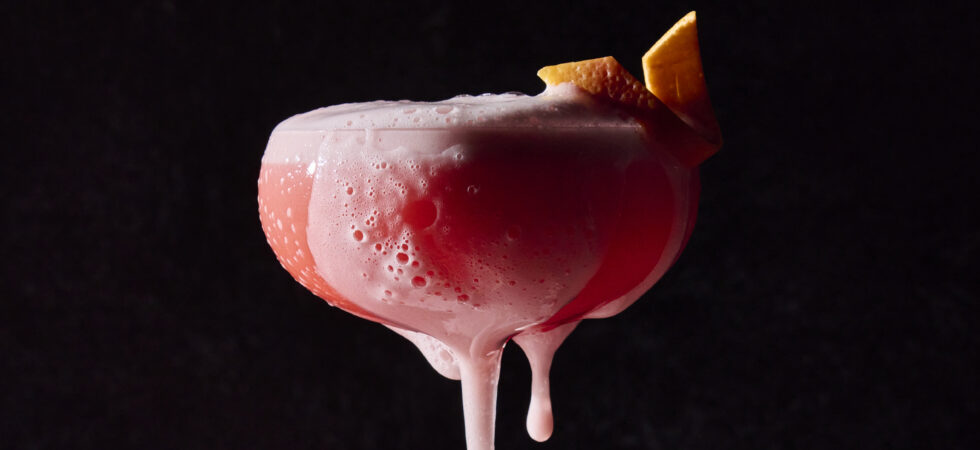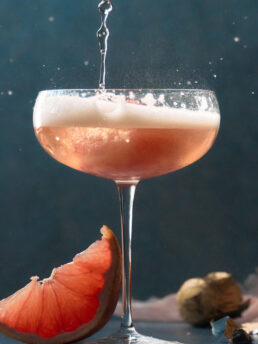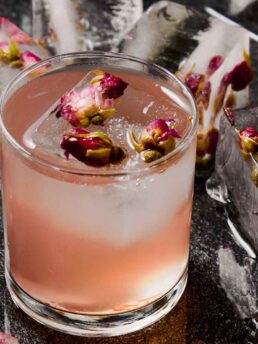Grapefruit-Champagne Negroni Sour

The Grapefruit-Champagne Negroni Sour offers the perfect balance for anyone who finds Campari too bitter and Aperol too sweet or bland. Fresh grapefruit juice, Champagne syrup, and egg white transform the traditional Negroni into a vibrant sour that strikes the ideal balance between the two liquors. The result is a lush, citrusy drink with a hint of bitterness that adds just the right amount of intrigue.

Get the Recipe: Grapefruit-Champagne Negroni Sour
Ingredients
Champagne Syrup
- ½ cup Champagne or sparkling wine made in the "Traditional Style", (see FAQs)
- ¼ cup refined granulated sugar
Grapefruit-Champagne Negroni Sour
- 1 oz grapefruit juice, fresh squeezed
- ½ oz egg white or vegan foam alternative, (see FAQs)
- ½ oz Champagne syrup
- ½ oz Cocchi Americano Bianco
- 1 oz Campari
- 1 oz Leopold Bros Summer Gin
- 2-3 dashes grapefruit bitters , optional
Equipment
- measuring Cups
- 1 small pot
- 1 Whisk
- 1 coupe or rocks glass
- 1 y-peeler or cheese peeler
- 1 paring knife
- 1 cutting board
- 1 citrus reamer or juicer
- 1 small bowl
- 1 cocktail shaker
- 1 Fine Mesh Strainer
- 1 Hawthorne Strainer
Instructions
Champagne Rich Simple Syrup
- Add the Champagne to a small saucepan over medium heat until it has reduced by half. Then, pour in the sugar and stir until it has dissolved. Once you can no longer see any sugar granules, remove the syrup from the heat and let it cool at room temperature or in your refrigerator.
Grapefruit-Champagne Negroni Sour
- First, place a coupe or rocks glass in the freezer 15-30 minutes before making the cocktail. Next, clean the skin of a grapefruit. Then, use a y-peeler or cheese peeler to create a roughly 1in x 3in (2.5cm x 7.6cm) long strip of grapefruit peel. Clean up the edges, shaping the peel into a parallelogram with a knife. Then, create a slit down the center of the peel leaving roughly .5in (1.3cm) of clearance at the top and bottom. Set your garnish aside.
- Next, cut and juice the grapefruit. Strain its contents into a separate container for the cocktail. Next, crack the egg and separate the yolk from the white. Whisk the egg white to loosen the protein structure up a bit and set it aside.
- Now, measure out and add all the listed cocktail ingredients to a shaker. Cover and shake for 15 seconds without ice (dry shake). Then, top with ice, close the shaker, and vigorously shake everything for about 30 seconds.
- Double strain the cocktail through a Hawthorne and fine mesh strainer, into either a coupe glass (sans ice) or a rocks glass (with a large ice cube). Express the grapefruit peel over the drink by holding the top and bottom of peel horizontally and facing out. Squeeze down to release the oils. Rub the outside of the peel against the rim of the glass. Twist the peel after it's expressed and slide it onto the rim of the glass using the slit in the center.
Notes
- If you forget to chill your glass, just fill it with ice and set it next to your workstation while you prep the cocktail. Dump the ice right before shaking the cocktail to have it ready.
- You won’t need an entire egg white for each cocktail. One large egg’s white should be enough for 2-3 cocktails.
- The egg white foam sets faster and lasts longer in this cocktail because the acid from the grapefruit juice acts as a stabilizer. Neat right?!
- The champagne syrup makes enough for 8 cocktails and lasts up to 3 weeks when stored in the refrigerator.
- Store your vermouth in the refrigerator for 1-2 months after opening. Remember, vermouth is wine with liquor in it. While the spirits slow down the fermentation that occurs when wine is exposed to air, it won’t last forever.
- Don’t have access to the gin or vermouth listed? Choose a citrus-forward gin for a similar flavor profile and either a French Blanc Vermouth or another Italian Bianco Vermouth (see FAQ for suggestions).
- I know it seems counterintuitive to strain the grapefruit juice both before and after shaking the cocktail, but the second strain ensures ice chips don’t end up in your drink and ruin the texture. I find that citrus pulp slows down the second strain if you don’t remove it beforehand. Honestly, both strains are optional, but I think it’s worth it for the best texture and if you plan to make more than one cocktail.
Nutrition

Frequently Asked Questions
There are a lot of variations of the Negroni out there, but purists will say it’s not a Negroni without Campari (I’m in this boat). Others believe a Negroni is the combination of a high proof spirit, a bitter liqueur, and vermouth. (To me: this is negroni-esque, but you’ve made a different cocktail.)
Any way you stir it, all variations are delicious!
Vermouth is a fortified and aromatized apéritif wine, made with a base of wine fortified with a stronger neutral spirit (typically brandy) to extend its shelf life. Various herbs, spices, and barks are then infused into the mixture. Europeans require the use of wormwood (commonly found in absinthe) for the spirit to be classified as vermouth. In contrast, Americans do not have this requirement, leading to modern vermouths with a wide range of flavor variations.
There are several styles of vermouth, from extra dry to sweet, but the main three are sweet, dry, and blanc. Traditional sweet vermouths are usually red and Italian in origin, while dry vermouths, straw-colored, come from France. Blancs (French) and Bianco (Italian) share a debatable origin story and offer the sweetness of red vermouths with the pale color of dry vermouths.
Most vermouths, including rosso or “red” vermouth, are made with white wine. They are then colored with caramelized sugar or caramel coloring. The tannins in red wine can interfere with the flavor and production process, so red wine is rarely used.
I’ve said it once, and I’ll say it again…you can do absolutely anything you want!
Cocchi Americano Bianco is a Bianco vermouth. If you cannot find it, stick to a similar flavor profile. Purchase either a (French) Blanc or (Italian) Bianco Vermouth. Look for tasting notes of lemon peel, Genitian root, chamomile, and black tea.
If you want to experiment, use any style of vermouth listed in the previous section.
Okay, here’s the deal. No, you don’t have to use Champagne, but you do need to use a sparkling wine that has character.
What does this mean?
A very light, crisp sparkling wine won’t create a syrup with much flavor. Reducing wine that lacks character results in a similarly bland syrup. For the syrup to work effectively, it needs to have enough flavor to stand up to both the Campari and the grapefruit juice.
Choose a sparkling wine either made in the “traditional style” or has bold flavors—something fruity, funky, buttery, or bready. I used a Pét-nat for the syrup during recipe development, and it turned out great if you want to go au naturel.
Be bold! I promise you’ll be rewarded.
P.S. This syrup is a great replacement for honey in vinaigrettes and drizzles on desserts.
For the same flavor profile, go for something orange, lemon, and coriander forward with less pepper and juniper pungency. Think light and clean.
Some other brands that follow that prompt are… Big Gin London Dry, Empress 1908 (the purple one), Roku London Dry, Sorgin Gin and Bombay Sapphire.
1. Aquafaba: The liquid from canned chickpeas, is one of the most popular alternatives, mimicking the texture and froth of egg whites. It does have a subtle flavor, so I wouldn’t suggest using it in delicate cocktails. The Campari in this Negroni Sour should mask it well. Substitute egg white for aquafaba in a 1:1 ratio by volume and follow the same shaking instructions. Fair warning, you might need to shake the cocktail longer to create the desired foam. Aquafaba has a slightly different protein structure than egg white, so it doesn’t develop as quickly.
2. Fee Brothers, fee foam: This egg white alternative can be purchased online or at most large liquor stores. It does create foam, just like egg whites, but the texture is slightly different than an egg white. You will still get the visual and some added texture, but without the same protein structure, it’s not quite the same. It’s definitely a solid choice if aquafaba isn’t in reach. Add 1-3 dashes of the liquid to your cocktail shaker and follow the instructions as written.
3. Soy Lecithin: This powder is an emulsifier, meaning it helps bind ingredients together and create a stable foam, made from soybeans. It’s not going to affect the viscosity or creaminess of the cocktail in the same way as egg whites, aquafaba, or xanthan gum will, but it will do the trick. Add ¼ to ½ teaspoon (.7-1.4g) of soy lecithin powder to your cocktail ingredients before shaking.
4. Xanthan Gum: Another powder, xanthan gum, is a thickening agent and stabilizer which creates a velvety texture in cocktails but will not produce as airy of a foam. Sprinkle ⅛ teaspoon (.4g) of xanthan gum (a very small amount) into your liquid ingredients before shaking to incorporate this ingredient.



